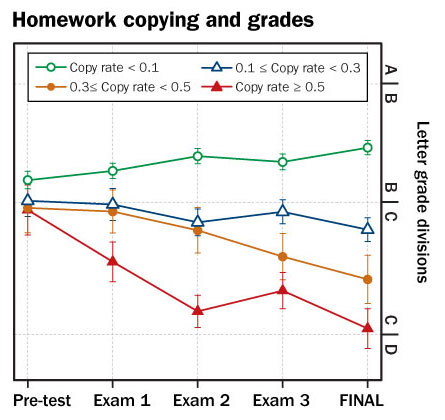- More than 2 years ago
A detailed study of college-level physics courses confirms students’ deepest fears: Homework really is important. Students who regularly copied problem sets earned lower grades and were three times as likely to fail the class, the study found.

“Homework copying is severely impeding students’ learning, and teachers don’t take it seriously enough,” says study coauthor David Pritchard, a physicist at MIT. “It’s a killer for the grades and a killer for the students.” The study appeared March 18 in Physical Review Special Topics–Physics Education Research.
Students at MIT and other universities commonly complete homework using an online system, giving Pritchard and his colleagues a wealth of data to analyze. The team tracked homework for four terms of introductory, calculus-based physics, a requirement for all MIT undergraduates. Since all of the students’ entries were time-stamped, Pritchard and his colleagues knew how quickly the problems were completed once the question appeared on the screen.
In the team’s analysis, three clusters emerged: One group of students solved the problems about 10 minutes after the problem first popped up, another answered a day or two later, and a third typically answered correctly in about a minute. Because the online system presents problems one at a time, it precludes working out all of the answers ahead of time and entering them all at once.
“Our first reaction was “Wow, we must have some geniuses at MIT’,” Pritchard says. The team soon realized that the answers in this quick-solving group were entered faster than the time it takes students to read the question, raising suspicions that these students had a cheat sheet of copied answers.
Equating speedy answers with copying, the team concluded that about 10 percent of the students copied more than half of their homework, about 40 percent copied 10 to 50 percent of their homework, and about half the students copied less than 10 percent of their homework. By the end of the semester, students who copied 50 percent or more homework earned almost two letter grades below students who didn’t copy very much, the team found. Heavy copiers were also three times more likely to fail the course.
Other patterns emerged from the data as well. Students who copied were much more likely to put off the majority of their homework until the last minute. And copying rates increased dramatically after the first midterm.
In the study, the heaviest copiers were male, and although most of the students in the classes were freshmen and had yet to declare a major, subsequent analyses turned up an interesting trend: “Copying homework is a leading indicator of becoming a business major,” Pritchard says.
Pritchard’s team was able to reduce the copying level fourfold by changing the format of the classes and explicitly warning students that copying homework can damage grades.
While the study is interesting, it probably won’t change the way most teachers view homework because many teachers already know how valuable homework problems are, says David M. Cook, who is president of the American Association of Physics Teachers and taught physics for 43 years at Lawrence University in Appleton, Wisc.







